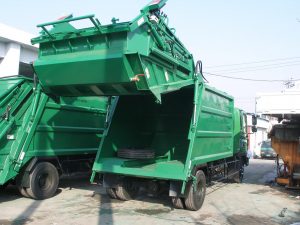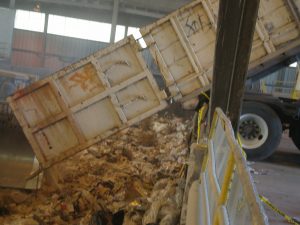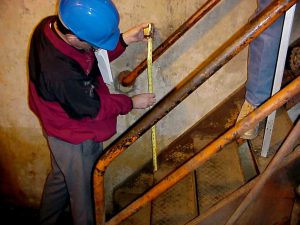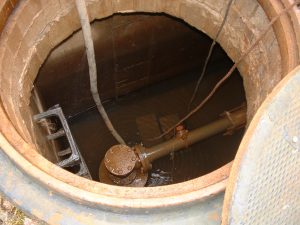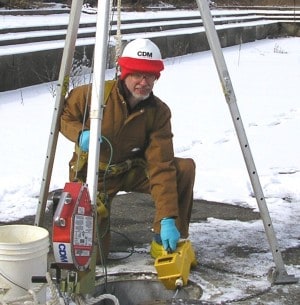Chris Marlowe, CIH, CSP
Landfills always put waste into confined spaces. When you put people into one, however, new dangers arise and OSHA’s Permit Required Confined Space standard applies. Although the standards provide valuable protection, they can really slow down work progress. A good strategy can provide safety while conserving effort.
Confined Spaces at Landfills
Some of the confined spaces that exist at landfills include:
- Leachate manholes
- Vaults containing landfill gas wellheads
- Utility vaults
- Incinerator fire boxes
- Access/cleaning pits under waste conveying equipment
- Alternate cover material mix tanks
- Storage tanks at hazmat collection areas
oWater wagon tanks
oFuel storage tanks
- Hoppers and containers on vehicles
- Waste processing hoppers
oe.g., shredders and compactors/baler (see Figure 1)
Three Characteristics of a Confined Space
The OSHA standards impose safety procedures on entries into permit-required confined spaces (PRCSs). No space is permit-required, unless it’s already a confined space. A confined space is any workspace that is 1) big enough to enter, 2) not designed for continuous employee occupancy and 3) hard to enter or exit. The preamble to OSHA’s 1993 PRCS standard clearly stated that all three criteria must be met in order for a space to be considered “confined.” (Federal Register Volume 58 No. 9 p 4477). Each of these elements is so important, that we will discuss them separately.
A space is “big enough to enter” when your whole body fits both 1) inside the space and 2) through the opening. The first part of this definition indicates that no matter how bad the air is in a five-gallon pail, that pail is not a confined space because your body would not fit inside. The second part of the definition means that no space is “confined” if every opening into it is covered with a welded grate through which your body can’t enter.
OSHA’s definition that “Entry occurs as soon as any part of the entrant’s body breaks the plane of an opening into the space,” appears to conflict with this definition; however, the definition of confined space takes precedence. For example, if you often wash the inside of a compactor truck with a hose, you have to put your hand inside. According to the policy, that’s entry. You need a permit for that work. If you weld rebar across the opening on 6” centers, the same behavior is not entry, and one person without a permit can do the task.
A space is “not designed for continuous employee occupancy,” when it’s:
- Designed to ever hold dense material (water, sludge, leachate or waste)
- Lacking heat, light and ventilation required by applicable building codes
- Too short to stand up in
- Too disgusting for you to put your desk in and work a whole day
One of our clients had a pump station, which met the other aspects of OSHA’s definition, but had continuously operating heat, light and ventilation. It was also a very clean work area. We determined that the dry well was 1) designed for occupancy, and therefore, 2) not a confined space, and 3) not a permit-required confined space.
If you have underground vaults that house valves, gauges or electrical equipment, you should ask, “What would it take to make the vault, ‘designed for occupancy?’” The second question you should ask is, “Would the savings on entry effort be worth the physical improvements?” The answer will often be, “No” (see Figure 2).
A space is “hard to enter and exit,” when you can’t walk normally on the way in and out. The preamble discussed previously establishes that “Doorways and other portals through which a person can walk are not limited means for entry or exit” (Federal Register Volume 58 No. 9 p 4477). When analyzed under this rule:
- Doorways are easy, if they are taller than the employee
- Stairs are easy, if they meet the OSHA standards
- Ladders, including ship ladders, are hard
- Hatches are hard
- Crouching is hard
- Crawling is hard
OSHA has determined (Interpretive Quip –Jmiles 951023) that “The use of a … stair meeting the specifications for a fixed industrial stair, securely installed, would provide an unrestricted means of entry or exit.” OSHA Standard 29 CFR 1910.24, for Industrial Stairs, requires stairways to have:
- Steps at least 22″ wide
- A slope between 30º and 50º above the horizontal
- At least 8″ of Slip Resistant Tread
- Vertical Clearance of 7′
- Platforms or landings at least 30″ on One Side
- Railings between 30″ and 34″ high
At many landfills, the specific design of the stairway becomes an issue. At one plant we found that the stairs in a well vault had:
- Treads 30″ wide and 10″ deep
- A slope of 39º
- One landing 29.5″ x 31″
- A handrail 33″ high
Because the stairs on this well vault meet the OSHA standard, the well is not a confined space, and, therefore, not a permit-required confined space (see Figure 3).
Note that a space that does not meet the definition as “confined” is not necessarily safe – it can still harbor hazards. Managers should still take appropriate action to control whatever hazards are present. Regulatory gymnastics should be used only to avoid regulation—driven efforts after practical safety is assured. We often use the OSHA procedures in hazardous spaces where the regulations don’t literally apply, simply because they make sense.
Permit-Required (Hazardous) Confined Spaces (PRCS)
OSHA safety procedures apply only to permit-required confined spaces. A PRCS is a confined space that has hazards such as: dangerous air, entrapment, engulfment or unguarded machinery (see Figure 4). Some confined spaces that have no demonstrable hazards include:
- Many well vaults that house:
- Continuous Pipe
- Valves
- Meters
- Wells
- Leachate manholes in new cells without:
- Connection
- Gassy soil
- Concrete sealant
- Standing water
“Hazard Evaluations” for Air-only Spaces
Careful reading of the OSHA definitions is not the only way to reduce the cost of confined space entry. Subparagraph 29 CFR 1910.146 (c)(5)(i) of the PRCS standard allows the use of “alternate procedures” when:
- Bad air is the only hazard
- Ventilation alone is sufficient to control that hazard
- Monitoring and inspection proves that sufficiency
- Entrants should show that they maintain:
- Barriers to prevent accidental falls
- Continuous forced air ventilation
- Periodic testing of air quality
- Certification of the lack of hazards
Because employer certifications must be backed up with facts that support the determination, you should produce an evaluation to show that all hazards are in control. In general, we have found few spaces where producing an air-only permit was worth the trouble. Consider the spaces at your landfill site (see Figure 5). Would any qualify for an air-only permit? Would the effort saved repay the effort involved in making the decision to justify and certify the finding?
“Hazard Evaluations” for Physical Conditions
Subparagraph 29 CFR 1910.146 (c)(7)(i) of the PRCS standard also allows the use of these “alternate procedures” when 1) no actual or potential atmospheric hazards are present and 2) all hazards within the space have been eliminated. The hazards that normally drive this decision include potentials for flow, energy or mechanical motion. OSHA’s definition of hazard elimination does not accept lockout of material or energy flow. The rule expects “double block and bleed,” which usually involves disconnecting the feed lines, inserting obstacles to block flow, and draining the pipe. As is true for the air-only condition, you should produce an evaluation to show that all hazards are in control.
Use Alternate Procedures
Contrary to common belief:
- Many small spaces are not “confined” under OSHA’s rules
- Many large, but sub-surface, spaces are
- Work in many confined spaces requires no permit
- Hazard evaluations will suffice for many confined spaces
Even when the exemptions we have discussed would allow one person to work in a confined space alone, it’s rarely a good idea, because outsiders can’t detect an injured employee inside the space. Use these alternate procedures if no single accident can befall more than one person at a time. That finding allows the use of a “buddy,” instead of an “attendant.” The buddy normally enters the space to work with the entrant, which often speeds the project.
Chris Marlowe is a Certified Industrial Hygienist and Certified Safety Professional who
specializes in the health and safety aspects of environmental operations. As CDM Smith’s (Edison, NJ) health and safety manager, he provides health and safety support to dozens of solid waste authorities, usually in problem situations, but also on day-to-day operations. Chris can be reached at (732) 590-4632 or via e-mail at [email protected].
Figure 1
The back of this compactor truck is a permit-required confined space.
Figure 2
Pits into which trucks dump waste are not designed for employee occupancy. Check whether they are easy to enter or exit.
Figure 3
You might have to take measurements to verify that your stairway meets the standards.
Figure 4
Expect air contaminants in vaults with standing water
Figure 5
The author collects air measurements at a confined space
Figures courtesy of Christopher Marlowe.

